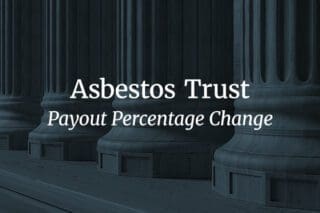
In January, the U.S. Geological Survey (USGS) released its annual summary of events and trends in valuable minerals. The report includes data on 2023 asbestos consumption. It also includes discussions of trends in asbestos use.
The United States has not produced asbestos since 2002. Since then, the country has relied on imports to handle manufacturing needs. The fact that domestic asbestos use continues may surprise some people. But asbestos is still not fully banned.
The USGS report tells a story of decreasing asbestos use in the United States. This downward trend represents a step toward protecting more people from asbestos exposure. Other key findings in the report include continued asbestos use in the chlorine industry and increased asbestos regulations.
1: Decline in Asbestos Use
In 2023, the United States consumed an estimated 150 metric tons of asbestos. This is a significant decline from peak consumption in 1973. That year, the United States manufactured and processed more than 800,000 metric tons of the mineral.
The United States did not import any asbestos in 2023 based on USGS data available through September of that year. It is possible the USGS will reveal 2023 imports in its next annual report.
All asbestos that manufacturers used through September 2023 came from existing stockpiles.
The report does not provide the exact size of the current U.S. stockpile. It only says the stockpile is small.
Which U.S. Industries Continue to Import Asbestos?
Two companies, OxyChem and Olin Corporation, are the primary asbestos users in the United States. The companies use the mineral as part of their chlorine production process at several plants throughout the country.
For decades, the companies insisted they protected workers from exposure at their chemical plants. Reporting from ProPublica in 2022 contradicted these statements. In 2023, Olin said it would support a federal asbestos ban.
2: Increased EPA Regulation
The USGS report also highlights an increase in regulatory scrutiny of asbestos use. For example, in July 2023, the Environmental Protection Agency (EPA) finalized stricter reporting requirements for many asbestos companies.
The report also discusses a proposed rule published by the EPA in 2022. The USGS released their report before the EPA finalized this rule in March. The rule bans the use of chrysotile asbestos. Chrysotile is a type of asbestos and is the only type currently imported or used in the United States.
The rule provides deadlines for companies to phase out their chrysotile use.
3: Companies Look for Alternatives to Asbestos
The USGS report also lists several substitutes for asbestos. Asbestos provides heat- and fire-resistance, durability and strength. It took pressure from regulators and asbestos lawsuits to get companies to finally abandon the dangerous mineral.
The decline in asbestos use has resulted in searches for materials that provide the same benefits as asbestos. Companies may use different materials depending on the property of asbestos they are trying to replicate.
The report does not review the safety of the listed asbestos substitutes. Some may pose health risks. For example, silica exposure can cause lung disease. And talc may be contaminated with asbestos. In recent years, talc manufacturers like Johnson & Johnson have come under fire for selling asbestos-contaminated talc products. Talcum powder users claim the company’s products caused them to develop mesothelioma and other asbestos diseases.




